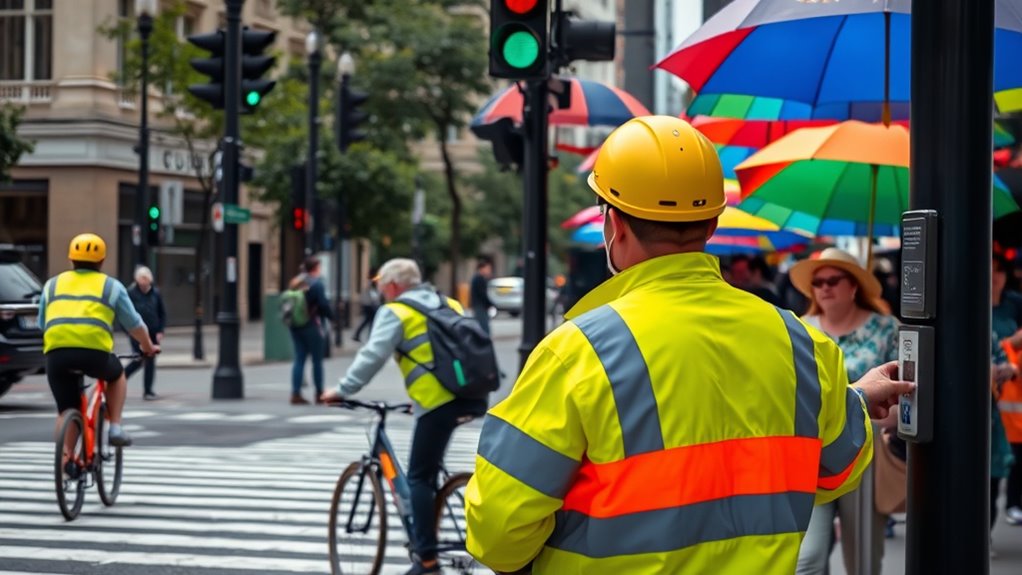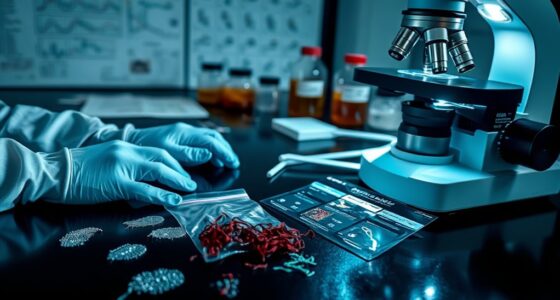You might not realize it, but advanced safety measures are constantly working to keep you secure. Hidden surveillance cameras monitor activity discreetly, while biometric and multi-layered access controls ensure only authorized individuals enter restricted areas. Cybersecurity protocols protect your data, and environmental sensors detect hazards early. Emergency plans and staff training enhance response times, and tamper-proof features keep systems intact. If you want to uncover more about these hidden precautions, there’s plenty more to explore.
Key Takeaways
- We use discreet, ethically managed surveillance cameras to deter crime while respecting privacy rights.
- Advanced multi-layered security protocols, including biometrics and physical barriers, ensure rapid response and unauthorized access prevention.
- Regular cybersecurity updates and employee training protect data, alongside clear evacuation procedures and emergency drills.
- Tamper-evident seals and environmental sensors provide early detection of unauthorized access and environmental hazards.
- Ongoing staff safety training fosters a culture of awareness, confidence, and quick emergency response.
Hidden Surveillance Cameras and Monitoring Systems

While hidden surveillance cameras and monitoring systems often go unnoticed, they play a critical role in maintaining safety and security. You might wonder about surveillance ethics and the hidden camera legality—both are indispensable to ensuring responsible use. These cameras help deter criminal activity and protect property, but they must be used ethically to respect privacy rights. Laws around hidden camera legality vary by location, so organizations must stay informed to avoid violations. When deployed correctly, hidden surveillance can be a valuable tool for safety without infringing on individual privacy. Understanding the private placement equity market and its trends can also inform organizations on strategic investments in security technology. A thorough understanding of security regulations is essential to ensure compliance and avoid legal issues. It’s essential to balance security benefits with ethical considerations, ensuring surveillance practices are transparent and lawful. Additionally, adopting ethical surveillance practices helps build trust within communities and prevents misuse of monitoring systems. Regular training on privacy rights ensures staff handle surveillance responsibly and ethically. Moreover, implementing payment processing security measures can further safeguard sensitive data from cyber threats. By understanding these aspects, you can be confident that security measures serve their purpose responsibly.
Advanced Access Control Measures

You might be surprised by how we enhance security with advanced access control measures. Biometric authentication guarantees only authorized individuals gain entry, while multi-layered protocols add extra protection. Plus, real-time access monitoring helps us respond immediately to any suspicious activity. Additionally, implementing security protocols ensures continuous safeguarding of our premises. We also regularly update our systems to address emerging AI vulnerabilities, maintaining resilience against potential threats. Incorporating biometric authentication further enhances security by uniquely verifying individual identities. To prevent internal risks, we conduct dynamic communication exercises that promote transparency and trust among staff.
Biometric Authentication Systems
Biometric authentication systems have become a cornerstone of advanced access control, leveraging unique physical or behavioral traits to verify identities quickly and securely. When you use biometric identification, you rely on your fingerprints, iris scans, or voice patterns instead of traditional passwords. These systems provide a high level of security because your biometric traits are nearly impossible to duplicate or share. They also streamline access, reducing the need for remembering codes or carrying cards. Enhanced security protocols by integrating biometric authentication help improve overall safety measures and minimize the risk of unauthorized entry. Furthermore, the integration of biometric systems with existing security infrastructure allows for more comprehensive safety management. Additionally, ongoing technological innovations are continuously improving the accuracy and reliability of these systems, including encryption techniques that protect biometric data during storage and transmission. Implementing these systems often involves compliance with privacy policies, which ensures that biometric data is handled responsibly and in accordance with regulations. This technology offers a seamless and efficient way to protect sensitive areas and information, ensuring only authorized personnel gain access. It’s a vital part of our commitment to keeping you safe through innovative security measures.
Multi-layered Security Protocols
Building on biometric authentication, implementing multi-layered security protocols creates a robust defense against unauthorized access. These measures protect employee privacy and ensure only authorized personnel enter sensitive areas. You’ll encounter physical barriers like locked doors, security checkpoints, and restricted zones that add extra layers of security. These barriers prevent casual or malicious intrusions, maintaining a safe environment. Additionally, access is granted only after multiple verification steps, such as PIN codes, card swipes, or security questions. This layered approach minimizes risks and keeps your workplace secure. Studies show that homes with security systems are significantly less likely to experience break-ins, highlighting the importance of comprehensive security measures. Incorporating security protocols ensures a systematic defense that adapts to evolving threats and maintains a secure environment.
Real-time Access Monitoring
Real-time access monitoring enhances security by providing immediate oversight of entry and exit activities across sensitive areas. You can see who is entering or leaving at any moment, helping prevent unauthorized access. With visitor logging, every visitor’s details are recorded instantly, ensuring a thorough record of all access attempts. This system actively verifies access authorization, allowing only approved personnel to enter restricted zones. If an unauthorized individual attempts to gain entry, alerts are triggered immediately, enabling swift response. By continuously tracking activity, you gain real-time insights into security breaches or anomalies. This proactive approach minimizes risks, increases accountability, and maintains a high level of safety. Overall, real-time access monitoring keeps your facility secure by ensuring that access is controlled, documented, and instantly observable.
Cybersecurity Protocols for Data Protection

While many people assume their data is safe, organizations implement rigorous cybersecurity protocols to protect sensitive information from cyber threats. You’re protected through measures like strong encryption algorithms that scramble data, making it unreadable to hackers. Phishing prevention strategies are also in place, helping you recognize and avoid fake emails that attempt to steal your information. These protocols guarantee that your data remains confidential and secure from intruders.
Key protections include:
- Regular updates to encryption algorithms to stay ahead of cyber threats
- Employee training on phishing prevention techniques
- Multi-factor authentication to add extra layers of security
Emergency Response and Evacuation Plans
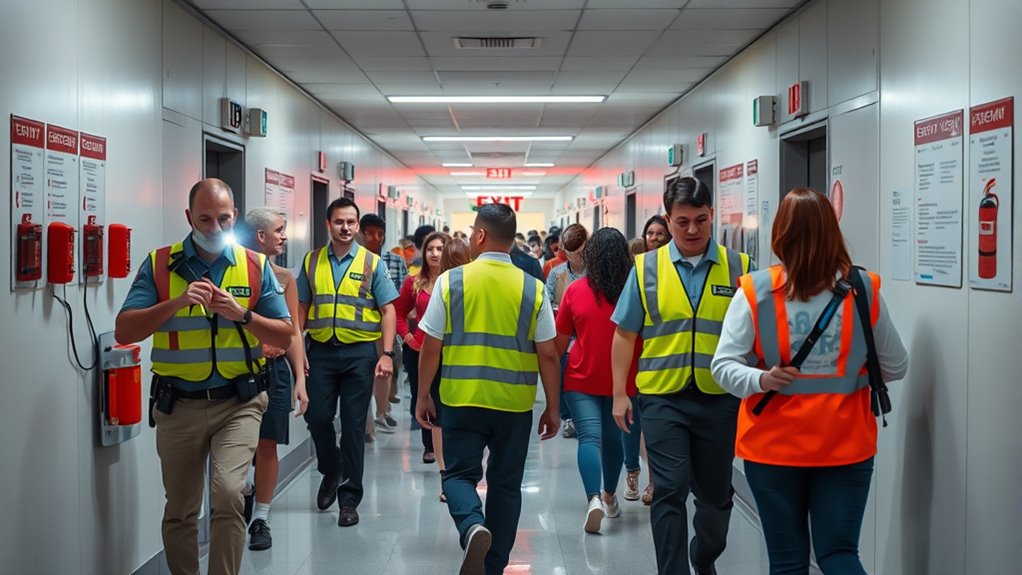
You’ll find that we have clear evacuation procedures in place to keep everyone safe. Regular emergency drills guarantee you know exactly what to do when seconds count. These preparations are designed to protect you and make sure help arrives quickly if needed.
Clear Evacuation Procedures
Clear evacuation procedures are essential to ensuring everyone’s safety during an emergency. You need to know the designated evacuation route and the closest assembly points ahead of time. This way, you can evacuate quickly and avoid confusion or delays. We’ve mapped out clear paths that lead you safely outside, avoiding hazards. Once you reach the assembly points, everyone gathers in designated areas to be accounted for.
- Familiarize yourself with the evacuation route posted throughout the building
- Know the location of all assembly points before an emergency occurs
- Follow staff instructions calmly and promptly to ensure a smooth evacuation process
Regular Emergency Drills
Regular emergency drills are a vital part of keeping everyone prepared and safe. These drills help guarantee that evacuation timing is quick and efficient, so you know exactly what to do when it counts. During each drill, we test our emergency communication systems to confirm that alerts reach everyone promptly. Practicing these procedures allows you to move calmly and confidently, reducing chaos during a real emergency. We regularly review and update our plans based on drill feedback, making sure every team member understands their role. By participating in these drills, you help us improve response times and strengthen safety protocols. Ultimately, regular emergency drills keep you informed, prepared, and confident that we’re ready to protect you in any situation.
Anti-Tampering Security Features
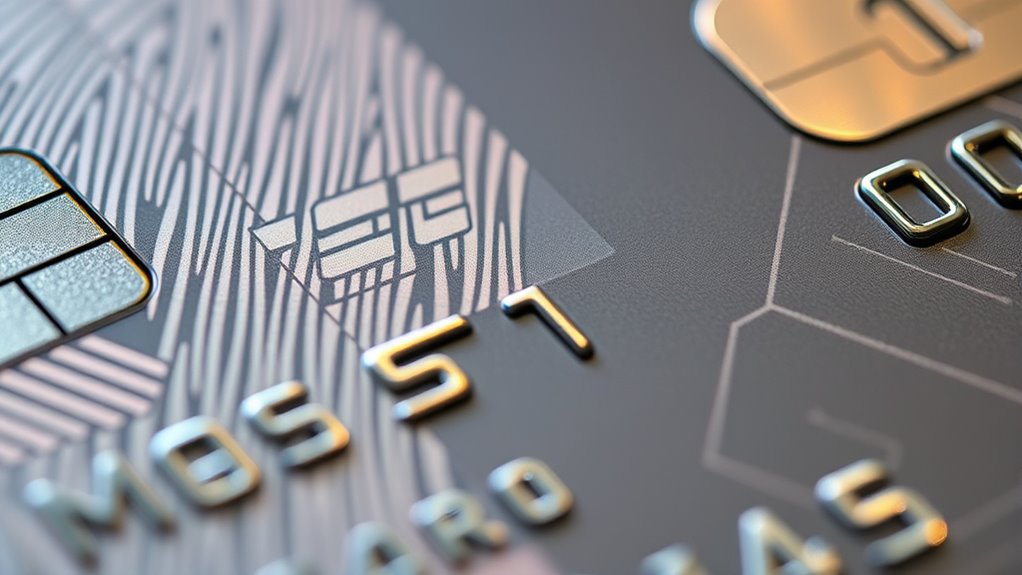
Anti-tampering security features are designed to detect and prevent unauthorized access or interference with a product or system. These security enhancements help you stay ahead of tampering attempts, ensuring your safety and the integrity of our operations. By implementing advanced measures, we make tampering prevention difficult and quickly identify any suspicious activity.
Anti-tampering features detect unauthorized access and safeguard system integrity effectively.
You might notice:
- Tamper-evident seals that show clear signs of interference
- Electronic alarms that trigger if someone tries to open or alter a device
- Secure enclosures with sensors that detect forced entry
These features work together to safeguard our systems, providing peace of mind that unauthorized access is unlikely. Our commitment to anti-tampering security features underscores our dedication to your safety and the reliability of our services.
Regular Staff Training on Safety Procedures
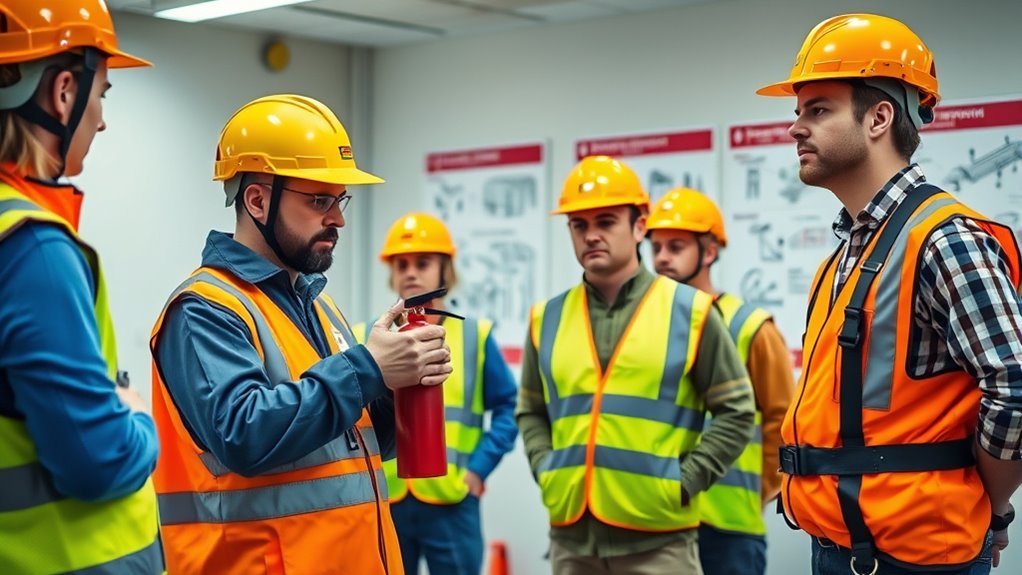
Since safety protocols are only effective if everyone understands and follows them, ongoing staff training is essential. Regular training sessions ensure staff stay current on safety procedures and maintain a high safety standard. During these sessions, you’re encouraged to provide employee feedback, which helps tailor training to real-world challenges and improve safety measures. We also emphasize obtaining and maintaining safety certification, guaranteeing staff are qualified and confident in emergency response techniques. This continuous education fosters a safety-first culture and reduces risks. By consistently updating training programs, we make sure safety practices are ingrained in daily operations. Your participation and feedback are crucial to creating a safer environment for everyone, reinforcing the importance of ongoing learning and commitment to safety protocols.
Environmental Sensors and Hazard Detection
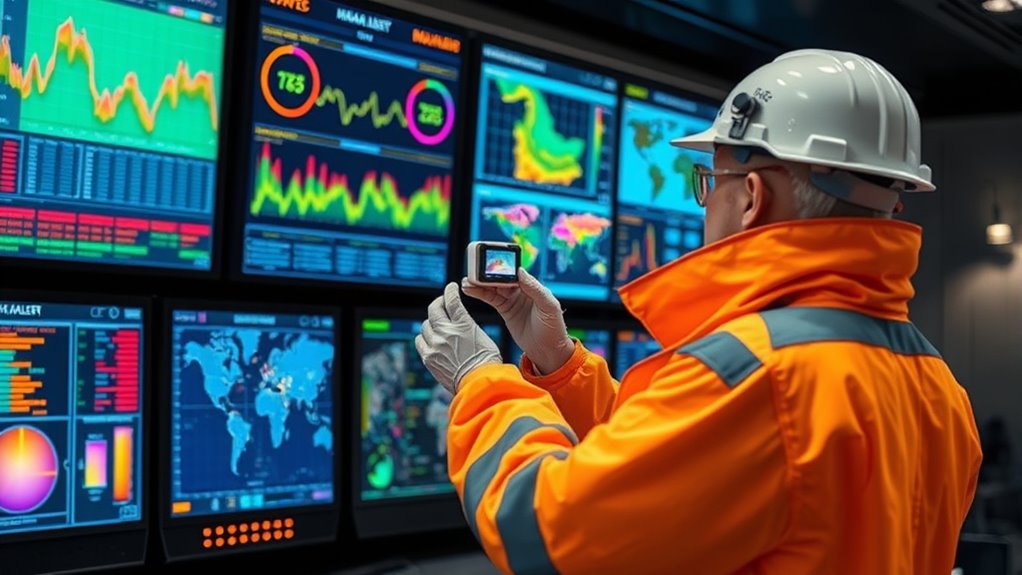
Environmental sensors and hazard detection systems play a essential role in maintaining safety by providing real-time alerts to potential dangers. These advanced tools monitor critical factors like air quality and noise pollution, helping prevent health issues and accidents. When air quality drops or noise levels become unsafe, the system instantly alerts you, so you can take immediate action. This proactive approach keeps everyone safe and comfortable.
- Detect harmful pollutants in the air before they cause health problems
- Alert you to dangerous noise levels that could impact hearing or cause stress
- Help identify environmental hazards early, reducing risk and ensuring quick response
These sensors work silently in the background, giving you peace of mind knowing safety is always a priority.
Biometric Identification Technologies
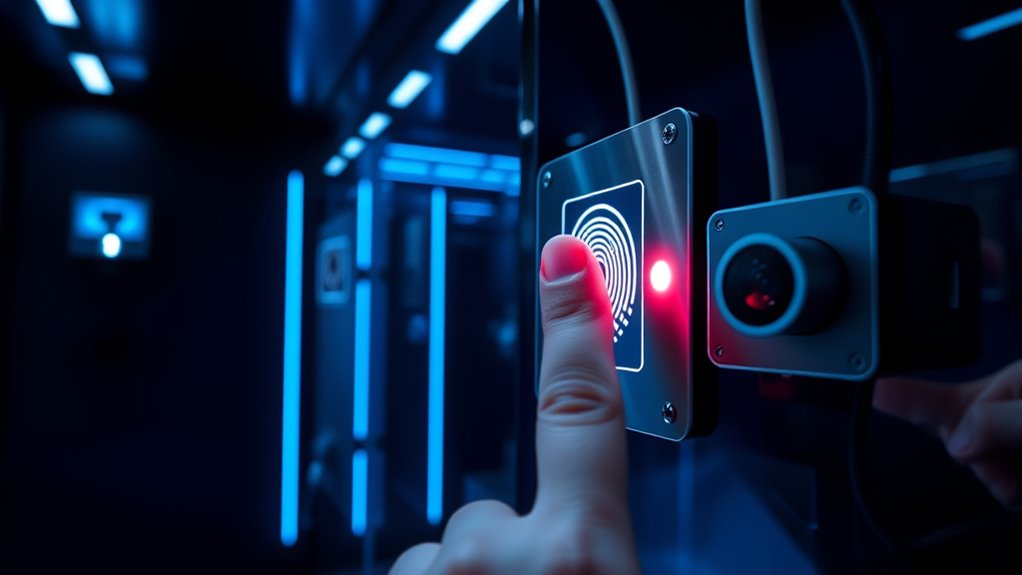
Biometric identification technologies have become integral to enhancing security by verifying identities quickly and accurately. You’re protected through biometric authentication methods like fingerprint scans, facial recognition, and iris detection. Facial recognition, in particular, helps us identify individuals in real-time, reducing unauthorized access risks. Here’s a quick overview:
| Technology | Purpose |
|---|---|
| Facial Recognition | Verifies identity via facial features |
| Fingerprint Scanning | Confirms individual through fingerprints |
| Iris Recognition | Uses eye patterns for identification |
Frequently Asked Questions
How Do We Ensure Privacy While Using Surveillance Cameras?
To guarantee privacy while using surveillance cameras, you follow strict privacy protocols, such as limiting access to authorized personnel and regularly reviewing footage. You also rely on camera encryption to protect data from hacking or unauthorized viewing. This way, you balance security with privacy, making sure that surveillance serves its purpose without compromising individuals’ rights. Implementing these measures keeps your environment safe and respects everyone’s privacy.
What Measures Are in Place to Prevent Cybersecurity Breaches?
Did you know that 68% of cybersecurity breaches happen due to inadequate protocols? To prevent this, we implement strict cybersecurity protocols and data encryption measures. You can trust that we regularly update our systems, monitor for threats, and restrict access to sensitive information. These proactive steps help protect your data from cyberattacks, ensuring your privacy remains secure and your information stays safe from breaches.
How Often Are Staff Trained on Emergency Procedures?
You’re regularly trained on emergency procedures through scheduled staff drills, ensuring everyone knows evacuation protocols inside and out. These drills happen at least twice a year, so you stay prepared for any situation. During training, you practice quick, safe evacuations and review protocols to handle emergencies efficiently. This ongoing education helps you respond confidently, minimizing risks and keeping everyone safe in real emergencies.
What Technologies Detect Environmental Hazards in Real-Time?
Think of environmental hazards as lurking shadows, ready to surprise you. You’re protected by advanced sensor integration that detects hazards in real-time, like smoke, gas leaks, or temperature spikes. These smart technologies act as vigilant guardians, constantly monitoring your surroundings. Hazard detection systems are essential—they alert you immediately, helping you stay safe and respond swiftly. This proactive approach guarantees your environment remains secure, even before danger can fully reveal itself.
How Secure Are Biometric Identification Systems Against Hacking?
Biometric identification systems face hacking vulnerabilities due to biometric flaws that can be exploited by hackers. While these systems are designed to be secure, no technology is entirely foolproof. You should know that advanced hacking methods can sometimes bypass biometric protections, making it essential to stay updated on security measures. Regularly changing your biometric credentials and employing multi-factor authentication can help mitigate these risks and enhance your overall security.
Conclusion
You might think staying safe relies only on visible measures, but hidden surveillance, biometric tech, and environmental sensors work behind the scenes to protect you. It’s like an invisible shield, constantly vigilant and ready to respond. Some say these layers of security are overkill, but history shows that unseen precautions often prevent disasters before they happen. Trust in these hidden safeguards—because the truth is, safety is always a blend of visible and invisible efforts.
